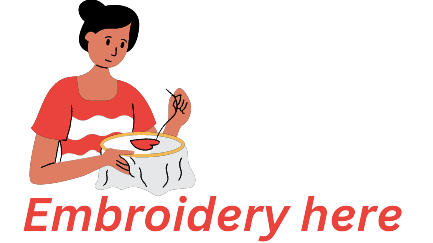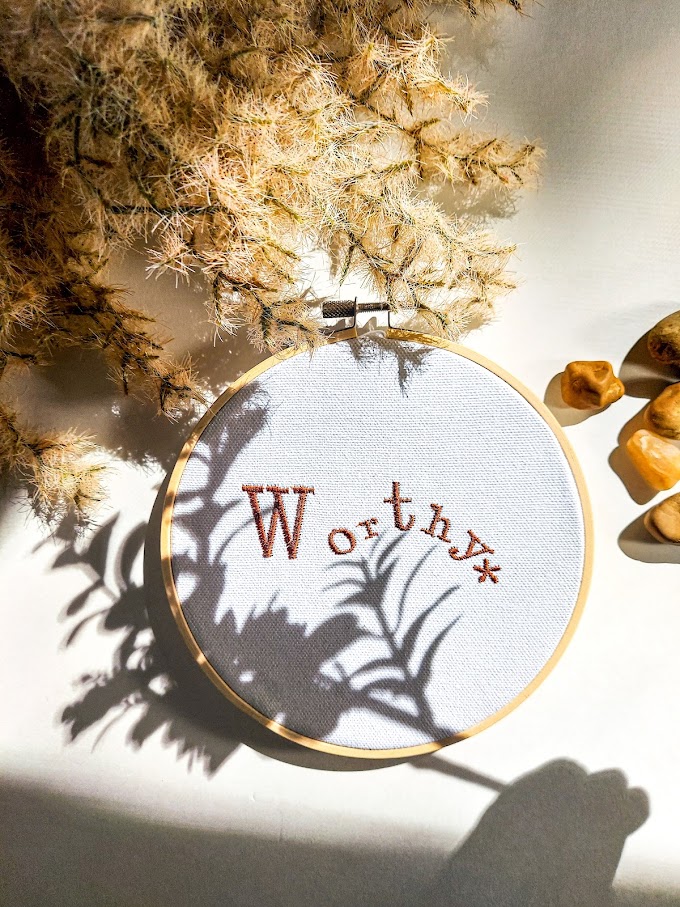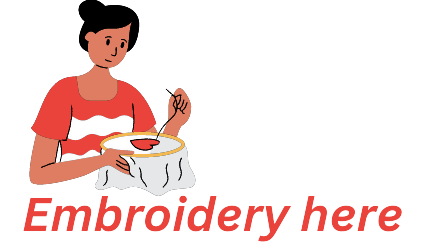If you are looking for a creative and relaxing hobby, embroidery might be the perfect choice for you. Embroidery is the art of decorating fabric or other materials with needle and thread or yarn. You can use embroidery to make beautiful and unique clothing, accessories, home decor, and art pieces. Embroidery can also help you express your personality and style, as well as improve your mood and mental health.
But how do you get started with embroidery? What are the different types of embroidery designs that you can try and enjoy? In this blog, we will answer these questions and more. We will introduce you to some of the most common types of embroidery designs and their characteristics. We will also give you some tips and resources on how to learn and practice embroidery.
Cross Stitch
Cross stitch is one of the oldest and most popular types of embroidery designs. It is also one of the easiest types of embroidery to learn and do. Cross stitch involves making small x-shaped stitches on a grid-like fabric called Aida or even weave. You can use cross stitches to create intricate and colorful patterns, often based on geometric shapes, floral motifs, letters, or images.
To do cross-stitch, you need a cross-stitch needle, cross-stitch thread, cross-stitch fabric, scissors, and a hoop or frame to hold the fabric. You also need a cross-stitch chart or pattern that shows you where to make the stitches and what colors to use. You can find many free and paid cross-stitch charts and patterns online or in books and magazines.
Cross stitch is a great type of embroidery for beginners as well as advanced embroiderers. It is easy to follow a chart or a pattern, and it does not require any special skills or techniques. You can also use different types of threads, such as cotton, silk, wool, or metallic, to create different effects and textures. Cross stitch is a fun and rewarding type of embroidery that can help you relax and enjoy your time.
Crewel
Crewel is a type of embroidery that uses wool thread to create raised and textured designs on a linen or cotton fabric. Crewel is also known as wool embroidery or Jacobean embroidery, as it originated in England in the 17th century and was influenced by the style of King James I. Crewel embroidery can feature various motifs, such as flowers, animals, birds, vines, or scrolls.
To do crewel embroidery, you need a crewel needle, crewel wool thread, linen or cotton fabric, scissors, and a hoop or frame to hold the fabric. You also need a crewel design that shows you where to make the stitches and what colors to use. You can find many free and paid crewel designs online or in books and magazines.
Crewel embroidery is a type of embroidery that requires some skill and technique. You need to know how to make different types of stitches such as stem stitch, satin stitch, chain stitch, or french knot stitch, and how to create different effects and textures with the wool thread. Crewel embroidery is a beautiful and elegant type of embroidery that can add a touch of sophistication and charm to your projects.
Applique
Applique is a type of embroidery that involves attaching pieces of fabric or other materials to a larger fabric using stitches or glue. Applique can create contrast and dimension to the embroidery design, as well as add interest and variety. Applique can be done with different types of fabrics, such as cotton, silk, felt, lace, or leather. Applique can also incorporate beads, sequins, buttons, or other embellishments. Applique can be used to create realistic or abstract shapes, such as flowers, animals, letters, or symbols.
To do applique embroidery, you need a needle, thread, fabric scissors, fabric glue (optional), and a hoop or frame to hold the fabric. You also need a applique design that shows you where to place the pieces of fabric and what stitches to use. You can find many free and paid applique designs online or in books and magazines.
Applique embroidery is a type of embroidery that requires some creativity and patience. You need to know how to cut and arrange the pieces of fabric and how to stitch them securely to the larger fabric. You can also use different types of stitches, such as blanket stitch, buttonhole stitch, or zigzag stitch, to create different effects and edges. Applique embroidery is a fun and versatile type of embroidery that can help you express your artistic vision.
Needlepoint
Needlepoint is a type of embroidery that uses a variety of stitches to fill in the entire fabric with thread. Needlepoint is also known as canvas work or tapestry work, as it is usually done on a stiff fabric called canvas. Needlepoint can create intricate and detailed designs, often based on historical or artistic themes. Needlepoint can be done with different types of threads, such as wool, silk, cotton, or metallic.
To do needlepoint embroidery, you need a tapestry needle, needlepoint thread, canvas fabric, scissors, and a hoop or frame to hold the fabric. You also need a needlepoint design that shows you where to make the stitches and what colors to use. You can find many free and paid needlepoint designs online or in books and magazines.
Needlepoint embroidery is a type of embroidery that requires some skill and technique. You need to know how to make different types of stitches, such as tent stitch, basketweave stitch, brick stitch, or bargello stitch, and how to create different effects and patterns with the thread. Needlepoint embroidery is a stunning and sophisticated type of embroidery that can add a touch of elegance and style to your projects.
Ribbon
Ribbon embroidery is a type of embroidery that uses silk or satin ribbon instead of thread to create delicate and elegant designs on fabric. Ribbon embroidery can create realistic or stylized flowers, leaves, stems, bows, or other shapes. Ribbon embroidery can also incorporate beads, pearls, sequins, or other embellishments. Ribbon embroidery requires a special needle called a chenille needle, which has a sharp point and a large eye to accommodate the ribbon.
To do ribbon embroidery, you need a chenille needle, silk or satin ribbon, fabric scissors, and a hoop or frame to hold the fabric. You also need a ribbon embroidery design that shows you where to make the stitches and what colors to use. You can find many free and paid ribbon embroidery designs online or in books and magazines.
Ribbon embroidery is a type of embroidery that requires some skill and technique. You need to know how to thread and knot the ribbon, how to make different types of stitches, such as straight stitch, lazy daisy stitch, or French knot stitch, and how to shape and manipulate the ribbon. Ribbon embroidery is a beautiful and elegant type of embroidery that can add a touch of luxury and romance to your projects.
Conclusion
These are just some of the types of embroidery designs that you can try and enjoy. Embroidery is a fun and creative hobby that can express your personality and style. Embroidery can also be a relaxing and rewarding activity that can improve your mood and mental health. Whether you are new to embroidery or an experienced embroiderer, there is always something new to learn and explore in the world of embroidery.
If you want to learn more about embroidery and how to do it, you can check out some of these resources:
- EmbroideryDesigns.com: A website that offers thousands of machine embroidery designs and digitizing services for all kinds of projects.
- Etsy.com: A marketplace that sells handmade and vintage goods, including many types of embroidery designs and kits.
- DesignsByJuJu.com: A website that offers high-quality machine embroidery designs for applique, quilting, redwork, and more.
- YouTube.com: A platform that hosts many videos and tutorials on how to do different types of embroidery by hand or by machine.
FAQ on Embroidery Design
What is embroidery design?
How do I choose the right fabric, needle, thread, and hoop for my embroidery design?
The choice of fabric, needle, thread, and hoop depends on the type and size of your embroidery design, as well as your personal preference and style. Here are some general guidelines to help you choose:
- Fabric: You can embroider on almost any fabric that is not too stretchy or too loosely woven. Some popular choices are cotton, linen, canvas, or muslin. You can also use pre-printed fabrics or fabrics with patterns or textures for added interest. If your fabric is lightweight or light-colored, you may want to use interfacing or a stabilizer to make it more stable and prevent it from puckering or showing through.
- Needle: You need to use an embroidery needle that has a larger eye than a normal needle to accommodate the embroidery thread. You can find different sizes and shapes of embroidery needles, depending on the type and thickness of the thread and fabric you are using. A good rule of thumb is to use a smaller needle for thinner thread and fabric, and a larger needle for thicker thread and fabric.
- Thread: You can use any thread that suits your fabric and your design. There are many types and brands of embroidery thread, such as cotton, silk, wool, or synthetic. The most common one is six-stranded cotton embroidery floss, which comes in a variety of colors and can be separated into thinner strands if needed. You can also use specialty threads such as metallic, variegated, or glow-in-the-dark threads for more effects.
- Hoop: You need to use an embroidery hoop to hold your fabric taut while you stitch. Embroidery hoops come in different sizes and materials, such as wood or plastic. Choose one that fits your fabric and your design. You can also use different shapes of hoops such as square, oval, or heart-shaped hoops for more variety.
How do I adjust the colors, size, or orientation of my embroidery design?
You can adjust the colors, size, or orientation of your embroidery design by using an editing software program that allows you to modify your design before stitching it. Some of the common editing functions are:
- Colors: You can change the colors of your embroidery design by selecting different thread colors from a color palette or by using a color chart that matches the thread brand you are using. You can also adjust the brightness, contrast, saturation, or hue of your colors for more effects.
- Size: You can resize your embroidery design by increasing or decreasing its dimensions in percentage or in inches or millimeters. You can also crop or trim parts of your design that you don’t want to stitch.
- Orientation: You can rotate or flip your embroidery design by changing its angle or direction in degrees or in horizontal or vertical axes. You can also mirror or duplicate parts of your design for more symmetry.
How do I hoop my fabric and start stitching my embroidery design?
Once you have transferred your embroidery design to your machine and chosen your fabric, needle, thread, and hoop, you are ready to hoop your fabric and start stitching.
- Hooping: To hoop your fabric, you need to loosen the screw of the hoop and separate the inner ring from the outer ring. Place the inner ring on a flat surface and lay your fabric over it. Place the outer ring over the fabric and press it down until it snaps into place with the inner ring. Tighten the screw of the hoop until the fabric is firmly held in place and there are no wrinkles or slack. Trim any excess fabric around the hoop if needed.
- Stitching: To start stitching, you need to thread your needle with one end of the thread and knot the other end. Bring the needle up from the back of the fabric to the point where you want to start stitching. Follow the outline of your design with the stitch of your choice until you reach the endpoint. Bring the needle down to the back of the fabric and secure it with a knot or a few small stitches. Cut off any excess thread with scissors. Repeat these steps for each part of the design until you finish.
How do I finish and display my embroidery design?
When you finish stitching, you need to remove any markings from your fabric with water or according to the instructions of your marking tool.
- Finishing: To finish your embroidery, you need to remove it from the hoop by loosening the screw and separating the rings. Press it with an iron from the back side to smooth out any wrinkles or puckers.
- Displaying: To display your embroidery, you can frame it in a hoop, in a picture frame, or in an embroidery stand. You can also sew it onto another item such as a pillowcase, a tote bag, or a jacket.





.jpg)
%20(1).webp)
.png)
%20(1).webp)


